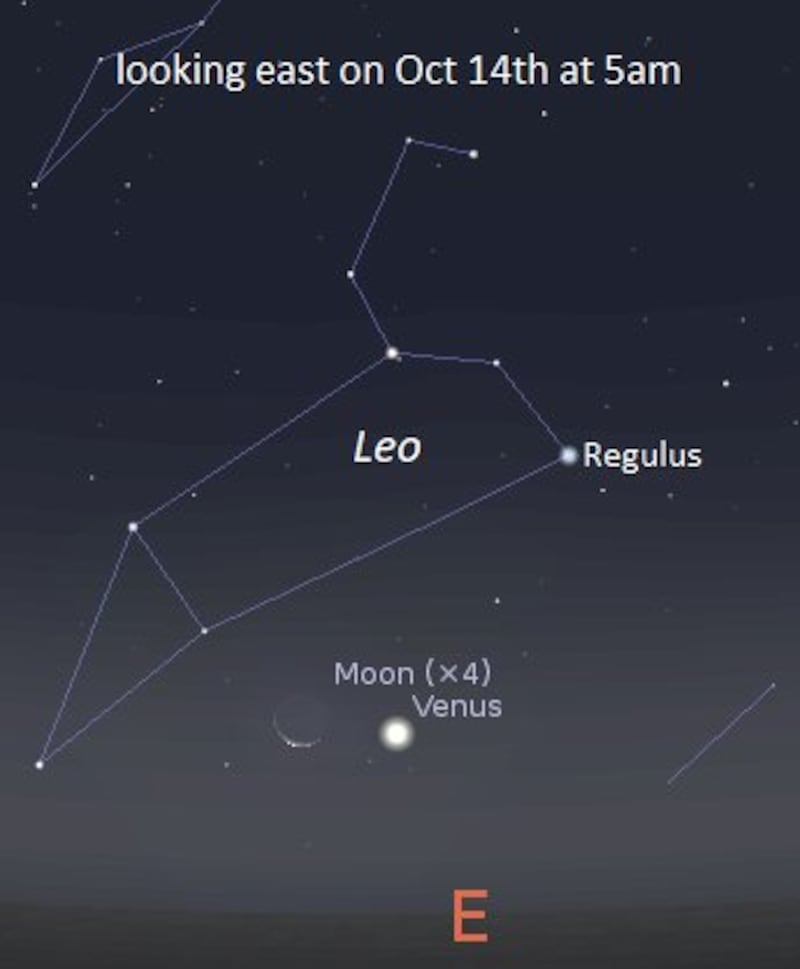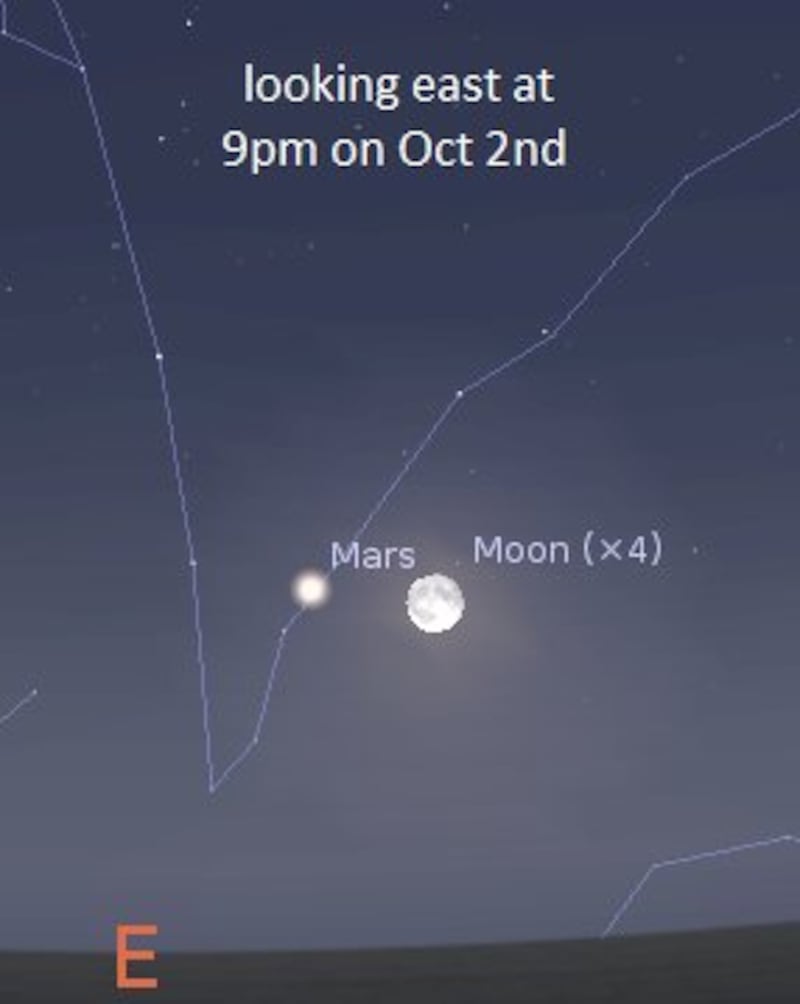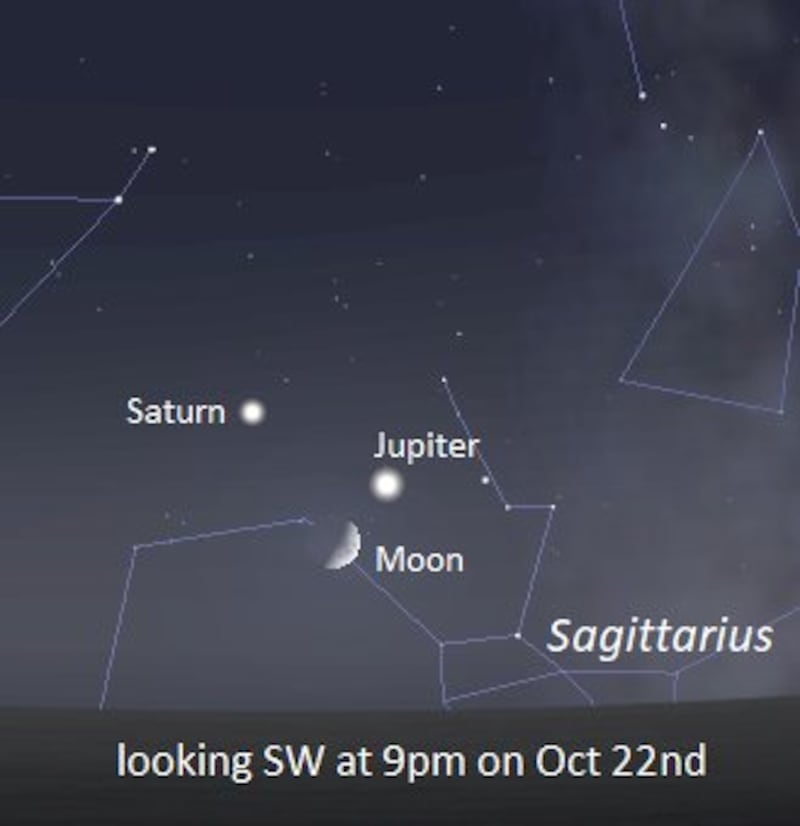Arrakis, the desert world at the centre of Herbert’s Dune saga, has similar conditions to what astronomers in the late-19th and early 20th centuries thought existed on the Red Planet: Life and difficult to extract sources of water.
Mars is about a third of the size of the Earth and has an eccentric orbit around the Sun that takes 687 days. Its axis is tilted a little more than 25 degrees so the planet experiences seasons like Earth, only twice as long, while a day on Mars, known as a sol, is 24.5 hours long.
Every 15 years we get a good opposition of Mars when it lies around 55 million kilometres from Earth, but a poor opposition sees the planet nearly twice as far away. Those times when closest allow us to scrutinise the planet in detail through a telescope, revealing polar ice caps and markings that change as they are covered or uncovered by shifting sands.
Mars outshines Jupiter all month and is quite striking amongst the dim stars of Pisces in the eastern sky from 8pm
The construction of large refractor telescopes in the 19th century allowed astronomers map Mars and the other planets as best they could from afar. A number speculated the markings on the Martian surface could be seas or even vegetation.
Italian observers in the late 1800s also charted straight slender features they named canali, or channels, which had the unfortunate consequence of being misinterpreted as “canals” by English publications. This implied they were artificial in nature and dug by intelligent beings.
Percival Lowell, who instigated the search for Pluto from his observatory in Flagstaff, Arizona at the turn of the 20th century, championed the canals through popular books and lectures. Mars was painted as a dying world whose engineers were attempting to draw water from the polar caps to the more arid equatorial regions.
Mars outshines Jupiter all month and is quite striking amongst the dim stars of Pisces in the eastern sky from 8pm
But not all astronomers were convinced. Many could not find evidence of waterways criss-crossing the planet and believed Lowell and his contemporaries were deceived by instrument issues or poor atmospheric seeing. Lowell died in 1916 but the interest in Martians did not wane. Authors like Wells and Burroughs kept alive the idea of an inhabited world, and attempts were even made in 1924 to listen for radio messages from the Red Planet.
Mariner IV made the first flyby in 1964 and numerous robotic vehicles have been since, including three missions that will reach Mars next spring.
At some point a crewed landing will take place - perhaps later this century - and the dream is to eventually settle Mars, though there will be many challenges beforehand. But humankind is destined to travel outward and explore, so that someday people will stand on the Martian surface and say, “this is home.”
The Moon
October had a full moon on the 1st and another is due on the 31st. The earlier is this year’s harvest moon while that on Halloween night is a blue moon going by the popular meaning of it being the second full moon in the same calendar month. The more correct almanac definition of a blue moon though is when it is the third of four full moons in a season. Last quarter moon is on the 10th, new moon is the 16th, and first quarter falls on the 23rd.
The planets
Mercury struggles above the eastern horizon a little after 6am the last couple of days of the month. Binoculars will tease out the planet’s faint spark in the approaching dawn.

Venus rises at 3:30am, or four hours before the Sun, at the beginning of October and about a half an hour later at the end of the month. It passes a moon-width from the bright star Regulus in Leo on the morning of the 3rd and the slender crescent moon is two days from new when nearby on the 14th.
Venus made headlines during September with the announcement that whiffs of phosphine in its atmosphere may indicate microbial life. It is important to note that life has not been found, just that it is one potential source for replenishing the gas after geophysical and chemical causes have been eliminated. Scientists are therefore keen to send an exploration mission soon.

Pumpkin-coloured Mars has a favourable opposition on October 13th when it is just over 62 million kilometres distant. The planet outshines Jupiter all month and is quite striking amongst the dim stars of Pisces in the eastern sky from 8pm. However, a telescope is required to resolve any detail on its surface. You will see the Moon near Mars on the evenings of the 2nd - it is even closer the next morning - and the 29th.
Jupiter and Saturn are now setting around midnight but are still well placed in the southern sky as darkness falls. The Jovian moons are a delight follow with standard binoculars from evening to evening as they circle their parent, while Saturn's largest moon Titan is a mote of light close to the planet in larger instruments. Saturn's globe is presently casting its shadow on the rings, giving a three-dimensional appearance to the view through a telescope.

Uranus reaches opposition in Aries on October 31st. It hovers at the limit of visibility with the unaided eye but can be easily seen in binoculars, so now is an ideal opportunity spot this distant world. When Uranus was discovered in 1781 it doubled the size of the then known solar system. The story - and a suitable chart to find it during 2020 - can be read in this Sky & Telescope article.
The Orionid meteor shower is at maximum during the early hours of October 22nd. Specks of dust shed by Halley’s comet as it orbits the sun give rise to the shower and the meteors are rather swift. The rates from the Orionids are moderate, with maybe 10 per hour seen during a normal maximum.
Spaceflight
The International Space Station is making a series of evening passes up to the end of the first week of October and will then be seen in the morning sky from the 23rd. That tees up nicely with the next Crew Dragon mission when four astronauts head for the station on a SpaceX Falcon 9 rocket. Their flight is currently scheduled for October 23rd but sightings of the capsule from Ireland as it closes in on the orbiting outpost depend on the Falcon's exact launch time.
The next official Expedition crew of three will launch to the ISS on a Soyuz spacecraft on October 14th while the current station residents return to Earth on the 21st.
Nasa’s OSIRIS-REx mission to the near-Earth asteroid Bennu is due to collect an initial sample from the 500m-wide object on October 20th. The spacecraft was launched in 2016 and reached Bennu in December 2018. OSIRIS-REx will depart for Earth in 2021 to return its precious cargo two years later.
John Flannery is a long-time amateur astronomer with an interest in the history and lore of the sky along with astronomical phenomena observable with the unaided eye. He is a member of the Irish Astronomical Society.















